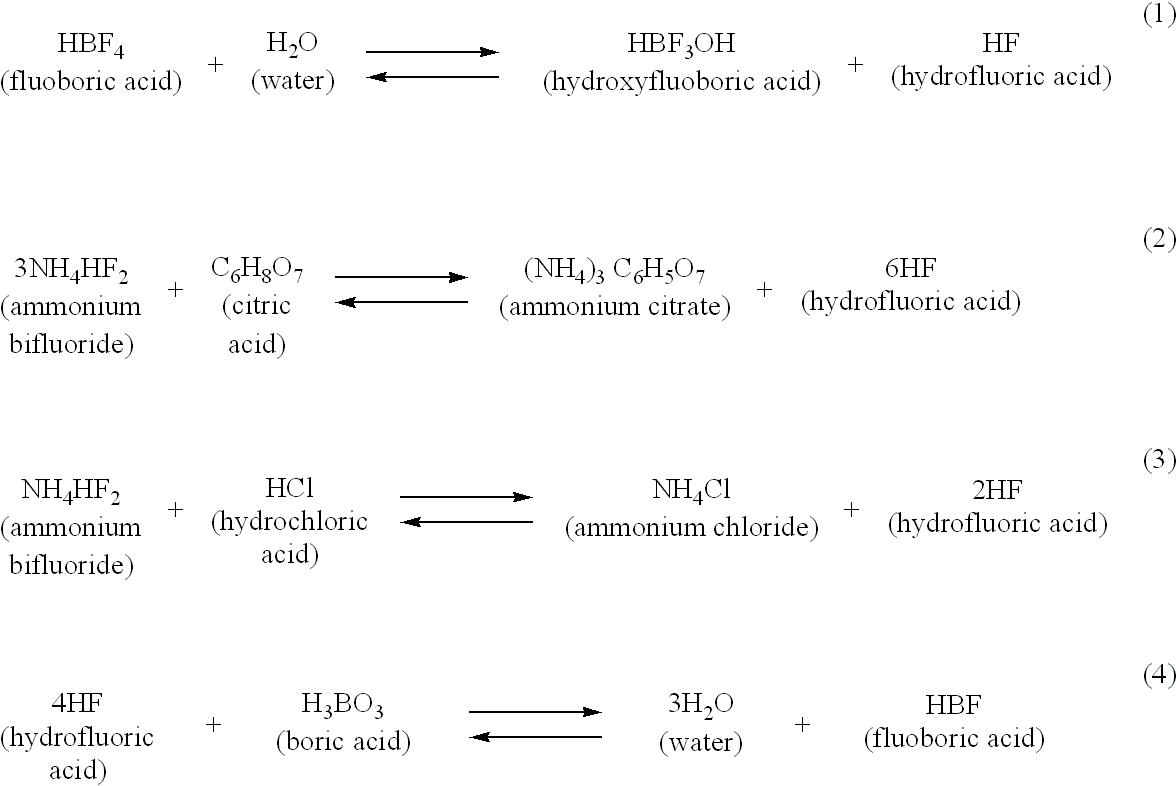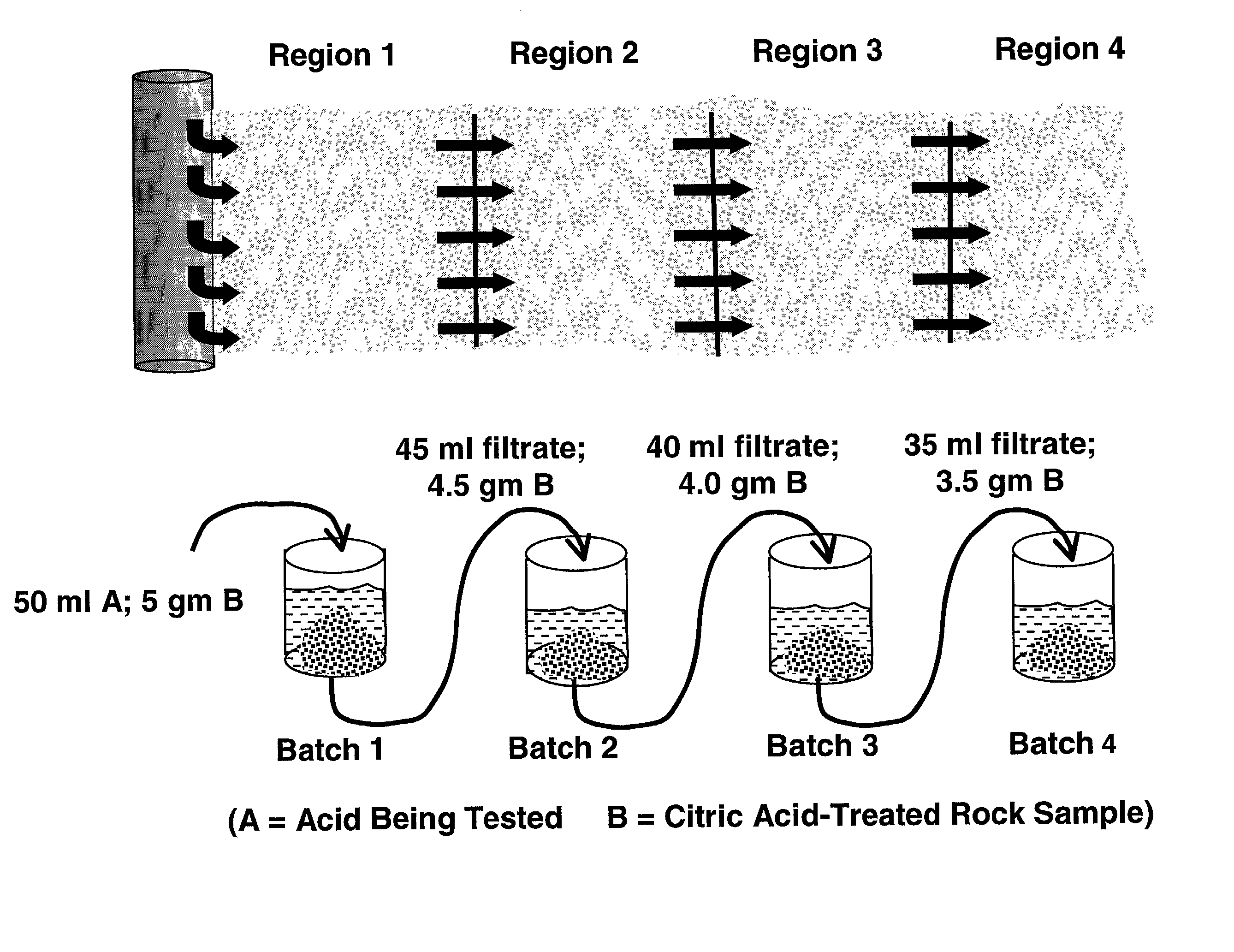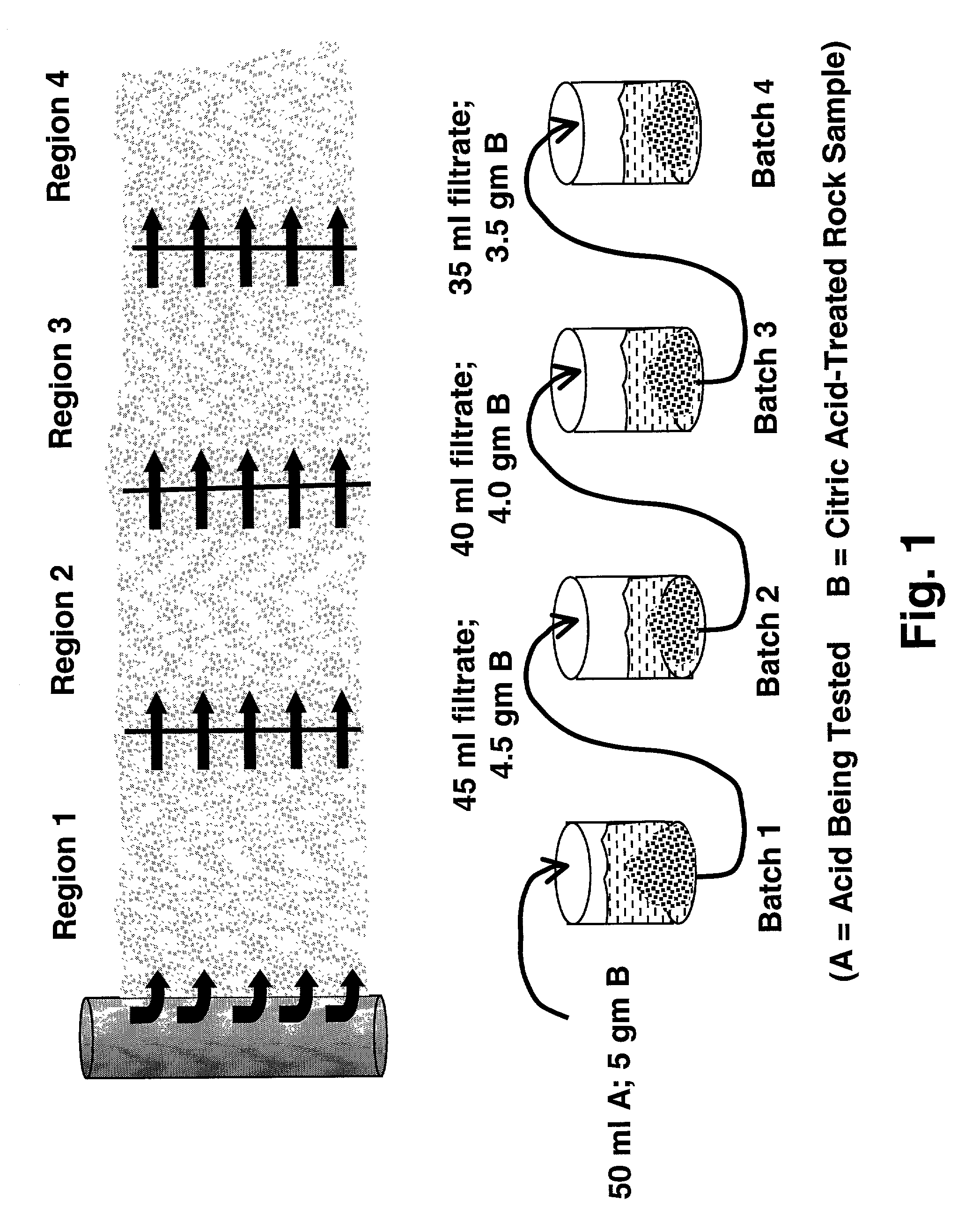Composition and method for treating a subterranean formation
a technology of composition and subterranean formation, applied in the field of new materials, can solve the problems of short-lived production improvement, inability to penetrate deep into the subterranean formation, and so on
- Summary
- Abstract
- Description
- Claims
- Application Information
AI Technical Summary
Benefits of technology
Problems solved by technology
Method used
Image
Examples
example 1
[0062] To illustrate the preparation of a composition of the invention, and how the concentration of HF may be fine tuned, the following procedure was conducted. About 3 wt % hydrofluoric acid (HF, MW=20), about 10 wt % citric acid, and water are mixed together to form a pre-composition blend or mixture. About 1.2 wt % boric acid (MW=61.8) is then blended with the mixture. Reaction of the boric acid with HF in the mixture results in the production of fluoboric acid, and reduces the free HF concentration to about 1.5 wt % in the final mixture. As will be appreciated, in order to remove 1.5 wt % (0.75 molar) HF from a 3 wt % (1.5 molar) HF solution by reaction with boric acid to form fluoboric acid (MW=87.8), a concentration of 0.188 molar boric acid is required in the mixture. That is, for every 4 moles of HF, 1 mole of boric acid (H.sub.3BO.sub.3) is required in the reaction mixture to produce 1 mole of fluoboric acid (eq. 4). Therefore, about 1.16 wt % of boric acid in a mixture wi...
example 2
[0067] Five samples from a sandstone subterranean formation in South America containing 58% quartz, 12% plagioclase, 4% calcite, 20% chlorite, and 6% smectite were prepared. The samples were then individually contacted with aqueous solutions comprising or formulated, as follows: 12 / 3 HCl / HF, 9 / 1 HCl / HF, 3 / 1 HCl / HF, fluoboric acid, and New Acid. The starting ingredients of the acid compositions are shown in Table 1.
1 TABLE 1 New Fluoboric 12 / 3 mud 9 / 1 mud 3 / 1 mud Acid acid acid acid acid Water (ml) 97.0 69.9 37.5 76.0 90.7 37% HCl (ml) 0.0 18.2 62.4 23.9 9.2 Ammonium bifluoride 9.8 12.0 4.8 1.5 1.5 (NH.sub.4HF.sub.2) (g) Boric acid (H.sub.3BO.sub.3)(g) 4.9 6.0 0.0 0.0 0.0 Citric Acid (C.sub.6H.sub.8O.sub.7) 13.4 0.0 0.0 0.0 0.0 (g)
Procedure
[0068] For each acid solution to be tested, a sequential spending test was performed to simulate the process of the acid penetrating into a subterranean formation and reacting with formation rock that had been preflushed with 10% citric acid. The t...
example 3
[0071] A synthetic blend of 90% 100 mesh silica sand with 10% zeolite was used to simulate a subterranean formation containing HCl minerals, e.g. zeolite, typically found in the Gulf of Mexico. Samples were contacted individually with solutions, as follows: 9 / 1 HCl / HF, 3 / 1 HCl / HF, fluoboric acid, and New acid. The test procedure followed was the same as that of Example 1. The results of the tests are shown in Table 3.
3 TABLE 3 Batch #1 Batch #2 Batch #3 Batch #4 Silicon Fluoride Silicon Fluoride Silicon Fluoride Silicon Fluoride New Acid 0.070 1.0 0.15 1.6 0.27 2.6 0.37 2.9 Fluoboric acid 0.095 0.99 0.14 1.4 0.19 1.7 0.19 1.7 12 / 3 mud acid 0.27 1.2 0.21 1.3 0.13 1.1 0.046 0.60 9 / 1 mud acid 0.088 0.47 0.11 0.45 0.11 0.46 0.11 0.45 3 / 1 mud acid 0.066 0.31 0.10 0.48 0.12 0.48 0.074 0.32
[0072] FIG. 4 shows graphically that the concentrations of Si did not increase substantially from Batch #1 through Batch #4 utilizing mud acids.
[0073] However the New Acid continued to dissolve minerals ...
PUM
| Property | Measurement | Unit |
|---|---|---|
| Fraction | aaaaa | aaaaa |
| Fraction | aaaaa | aaaaa |
| Time | aaaaa | aaaaa |
Abstract
Description
Claims
Application Information
 Login to View More
Login to View More - R&D
- Intellectual Property
- Life Sciences
- Materials
- Tech Scout
- Unparalleled Data Quality
- Higher Quality Content
- 60% Fewer Hallucinations
Browse by: Latest US Patents, China's latest patents, Technical Efficacy Thesaurus, Application Domain, Technology Topic, Popular Technical Reports.
© 2025 PatSnap. All rights reserved.Legal|Privacy policy|Modern Slavery Act Transparency Statement|Sitemap|About US| Contact US: help@patsnap.com



